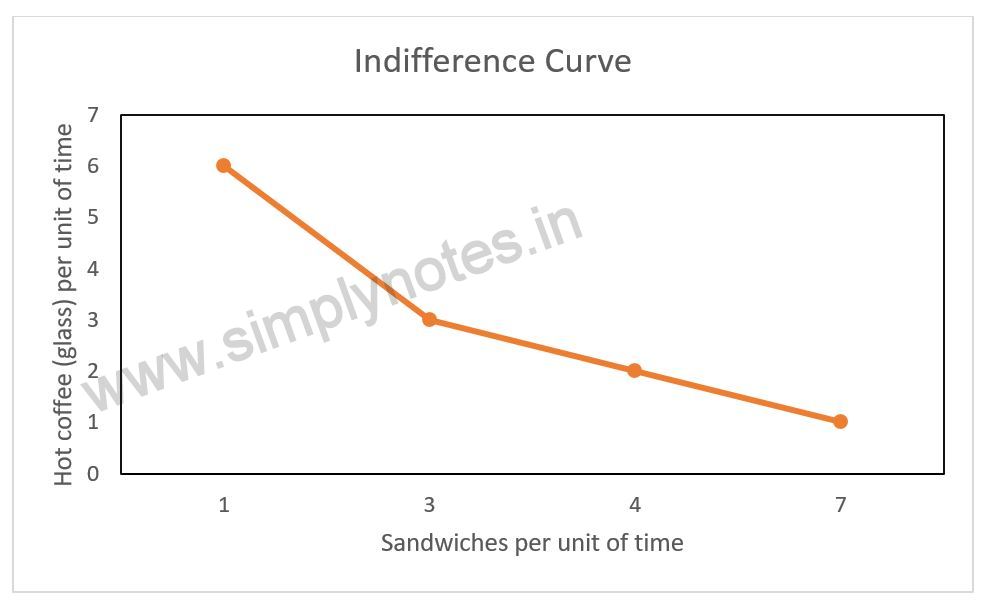Indifference Curve
Meaning, Nature, Assumptions, Properties and Limitations
Meaning and Nature of Indifference Curve
The realms of consumer behavior were expanded to new horizons with the introduction of indifference curve analysis by J.R. Hicks and R.G.D. Allen. The crux of this analysis is that utility is ordinally measurable. From the above discussion on ordinal approach, you can promptly infer that given two commodities M and N, a consumer is able to rank different combinations of the commodities in order of preference or indifference. If we plot the quantities of the two commodities on the two axes, then we can draw a set of points that would represent alternative combinations of M and N, between which the consumer would be indifferent. The curve formed by joining such points is known as an indifference curve.
We may define an indifference curve as the locus of points which show the different combinations of two commodities a consumer is indifferent about. Since all these points render equal utility to the consumer, an indifference curve is also known as an isoutility (“iso” meaning equal) curve. The tabular representation of such combinations is referred to as the indifference schedule.
The following table gives the indifference schedule between two commodities, say sandwich and hot coffee, consumed per unit of time. All the different combinations render the same level of total utility, namely U.
| Combination | Sandwich (M) | Hot coffee (N) | TU |
| A | 1 | 6 | U |
| B | 3 | 3 | U |
| C | 4 | 2 | U |
| D | 7 | 1 | U |
The first column of the table shows the corresponding points when plotted on graph. On joining all such points, we get what is known as an indifference curve, shown as I in Figure 1 .

Graph 2 shows the indifference curve drawn to scale from the figures given in Table. Let us explain the various aspects of such a curve now.

Each point on an indifference curve represents a consumption basket, having a combination of the two goods consumed. Thus point A on the curve shows a combination of 1 sandwich and 6 glasses of hot coffee, which would give the consumer the same level of satisfaction as 3 sandwich and 3 glasses of hot coffee, shown by point B, or 5 sandwich and 2 glasses of hot coffee, shown by point C, or 7 sandwich and 1 glasses of hot coffee, shown by point D. You may thus infer that the level of satisfaction remains the same at all points on the same indifference curve and the consumer would as such be indifferent between all such combinations of the two goods consumed.
The consumer can make many more combinations of the two goods, with less of any one, or both of the goods. Points below an indifference curve will have lesser utility than any point on the curve. In Panel “a” of the following figure , an indifference curve (say, Io) can be drawn through points below I1; each point on such a curve would give lesser satisfaction than points on I1. Similarly, an indifference curve (say, I2) can be drawn through points above I1; each point on such a curve would render greater satisfaction than those on I1. In fact, it is possible to draw numerous such curves like Io, I2 and I3, each representing a unique level of utility and none intersecting any other. The family of such indifference curves, shown in Panel “a”, is referred to as the indifference map.
Assumptions
You know that the basic premise is that the consumer is rational; besides the indifference curves analysis is based on certain other assumptions:
i. At any given point of time the consumer has only two goods in his/her consumption basket.
ii. It is not possible to quantify the utility’ availed from the consumption rather the consumer is able to rank his/her preferences on a scale.
iii. The consumer is never completely satisfied; this is in accordance to the assumption on nonsatiation you have read earlier in this chapter. In other words, more is always wanted.
iv. The consumer is consistent in his/her choices. This implies that if a consumer is indifferent between butter and ghee, and between ghee and cheese, he/she would be indifferent butter and cheese as well.
v. The two goods under consideration are perfectly divisible in small units. This implies that indifference curves would be continuous in nature.

